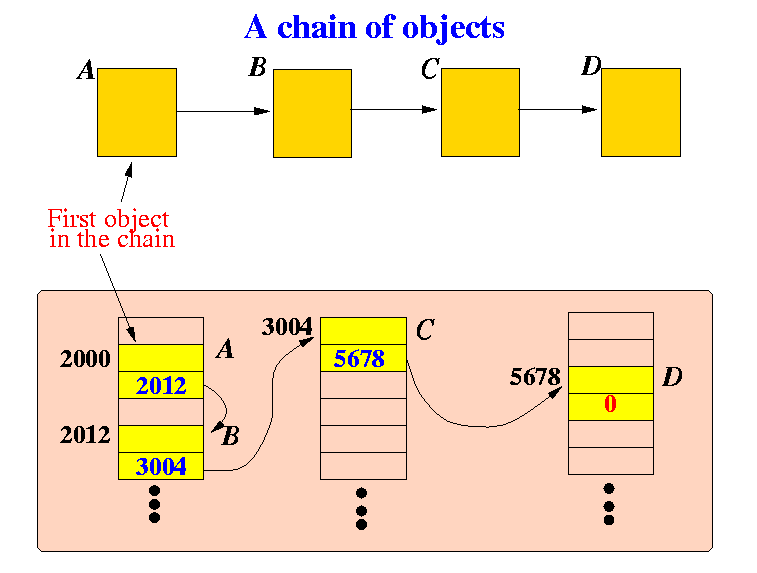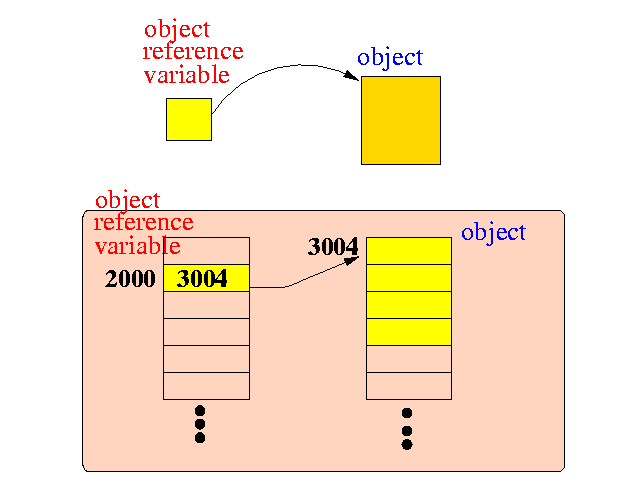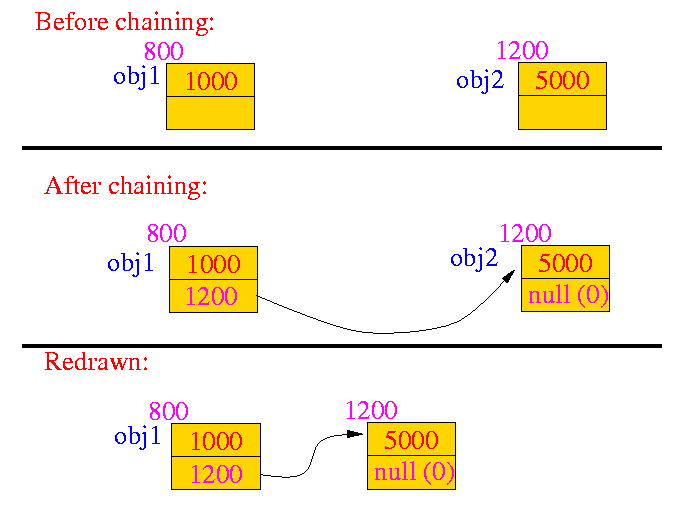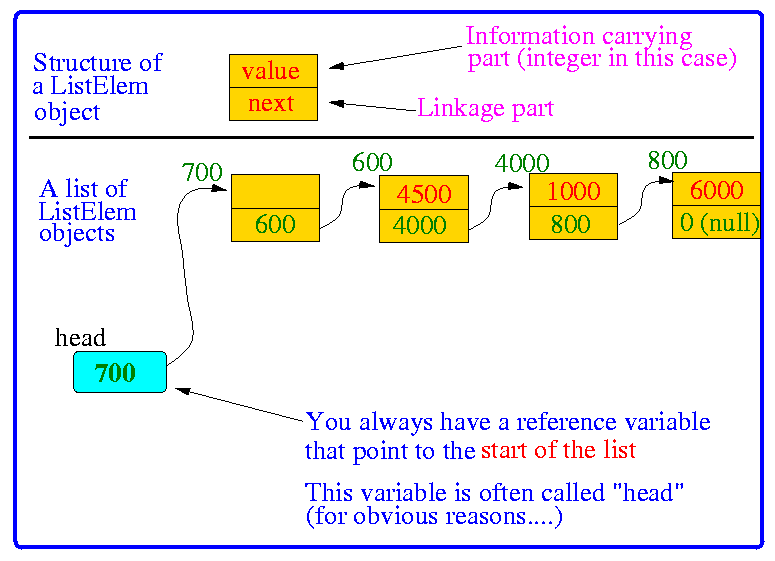- A linked list is
a dynamically growing/shrinking
"data structure"
used to organize a collection of
identical objects

Notice that the chain is contructed using references (i.e., addresses)
- Properties of linked lists:
-
The objects
are organized
into a chain
- We
only know
the
location (address) of the
first object
- Each object contains a
reference to one or more objects
- The objects
are accessed
starting from the
first object
by
following the chain in the references
- Notably:
- The number of elements in a linked list
can increase or
can decrease
- For this reason,
a linked list is known as a
dynamic data structure
(unlike an array where the number of elements does not change).
- The number of elements in a linked list
can increase or
can decrease
-
The objects
are organized
into a chain
- We will first look at the how to chain elements into a linked list ...
- Recall that is a
reference variable
can hold the address (location)
of some object:

- Key to creating
linked lists :
A link is created by including an reference variable in the object itself
- The following
sequence of steps
illustrates
how to link 2 elements together
- Each
linked list
element will
store an
integer value
- Step 1:
-
Define a class
type that can:
- Hold an integer value
- Hold a link to another element
This is the class definition:
class ListElem { public: int value; // Integer ListElem *next; // Pointer used to make link };
- Step 2:
Create 2 list elements :
ListElem obj1; ListElem obj2; obj1.value = 1000; obj2.value = 5000;In addition, the elements' value field have been initialized.
- Step 3:
make the
link
from
obj1
to
obj2:
obj1.next = &obj2;
- Step 4:
mark the
obj2
as the
end of the list
obj2.next = NULL; // = 0, it means "end"
This is what is going on inside the computer when you make a linked list:

- NOTE:
the next variable in
obj1 can be used
to find obj2
- So "logically speaking", these 2 objects now "are in the linked list"
- NOTE:
the next variable in
obj1 can be used
to find obj2
- There is one more thing missing
in the representation
of the
linked list
Although the linked list is created, we (as the programmer) need information about the linked list to use it
- The
information
that we need
to access
the elements in the
linked list is:
-
The location
of the
first element
of the list
- The type
of this information is:
(ListElem *) - So we define the following variable
to remember
the information:
(ListElem *) head; head = &obj1; // Remember the start of the list
- In general, a linked list
looks like this:

- A linked list without any element
is called an
empty list
- The empty list is indicated by
setting "head" to the special value NULL ("nowhere"):
head = NULL;
- Traversing a linked list means
visiting every element in the list While visiting the elements of the list, you can perform operation(s) on the elements.
E.g.: sum all the values stored in the list elements
- Unlike arrays which is a
random access data structure
(meaning that if you want to visit the
ith
element in an array, you
do not
have to
visit the i-1th element),
a
linked list is
a SEQUENTIAL access data structure:
-
If you want to visit the ith
element in a
linked list,
you
have to
visit the i-1th element
first
This is a "natural" consequence from the fact that the information necessary to access the ith element of the list (which is the location (address)) is stored in the i-1th element....
- Access any element in a linked list
always
begin with the
first element of the list.
Starting from the first element of the list, we find the location (through the pointer variable) of the next element; and so on.
- The following is a skeletal code
to
traverse
a linked list:
ListElem *head; // Assume: head points to the first ListElem... ListElem *p; // Auxiliary pointer variable to traverse list p = head; // Very important: start at first element while ( p != NULL ) { cout << p->value; // Access value stored in list element p = p->next; // Visit next element in list }
- Example Program:
(Demo list traversal)

- Prog file: click here
- The most tedious part of linked list is:
- inserting elements into the list, and
- delete elements from the list
- There are different ways
to insert a new element
into the list (or chain):
- add the
new element
at the start (head)
of the list
- add the
new element
at the tail (end)
of the list
- Maintain some ordering of
the list element based on
the value stored in the
list element
(Ordered list)
We will discuss these next...
- add the
new element
at the start (head)
of the list